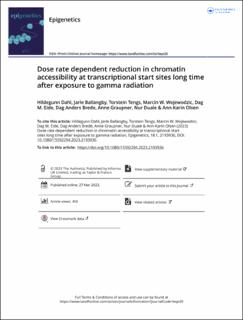| dc.contributor.author | Dahl, Hildegunn | |
| dc.contributor.author | Ballangby, Jarle | |
| dc.contributor.author | Tengs, Torstein | |
| dc.contributor.author | Wojewodzic, Marcin Wlodzimierz | |
| dc.contributor.author | Eide, Dag Markus | |
| dc.contributor.author | Brede, Dag Anders | |
| dc.contributor.author | Graupner, Anne | |
| dc.contributor.author | Duale, Nur | |
| dc.contributor.author | Olsen, Ann-Karin Hardie | |
| dc.date.accessioned | 2023-05-08T18:41:37Z | |
| dc.date.available | 2023-05-08T18:41:37Z | |
| dc.date.created | 2023-04-14T13:04:20Z | |
| dc.date.issued | 2023 | |
| dc.identifier.citation | Epigenetics. 2023, 18 (1), . | |
| dc.identifier.issn | 1559-2294 | |
| dc.identifier.uri | https://hdl.handle.net/11250/3067146 | |
| dc.description.abstract | Ionizing radiation (IR) impact cellular and molecular processes that require chromatin remodelling relevant for cellular integrity. However, the cellular implications of ionizing radiation (IR) delivered per time unit (dose rate) are still debated. This study investigates whether the dose rate is relevant for inflicting changes to the epigenome, represented by chromatin accessibility, or whether it is the total dose that is decisive. CBA/CaOlaHsd mice were whole-body exposed to either chronic low dose rate (2.5 mGy/h for 54 d) or the higher dose rates (10 mGy/h for 14 d and 100 mGy/h for 30 h) of gamma radiation (60Co, total dose: 3 Gy). Chromatin accessibility was analysed in liver tissue samples using Assay for Transposase-Accessible Chromatin with high-throughput sequencing (ATAC-Seq), both one day after and over three months post-radiation (>100 d). The results show that the dose rate contributes to radiation-induced epigenomic changes in the liver at both sampling timepoints. Interestingly, chronic low dose rate exposure to a high total dose (3 Gy) did not inflict long-term changes to the epigenome. In contrast to the acute high dose rate given to the same total dose, reduced accessibility at transcriptional start sites (TSS) was identified in genes relevant for the DNA damage response and transcriptional activity. Our findings link dose rate to essential biological mechanisms that could be relevant for understanding long-term changes after ionizing radiation exposure. However, future studies are needed to comprehend the biological consequence of these findings. | |
| dc.language.iso | eng | |
| dc.title | Dose rate dependent reduction in chromatin accessibility at transcriptional start sites long time after exposure to gamma radiation | |
| dc.title.alternative | Dose rate dependent reduction in chromatin accessibility at transcriptional start sites long time after exposure to gamma radiation | |
| dc.type | Peer reviewed | |
| dc.type | Journal article | |
| dc.description.version | publishedVersion | |
| dc.source.pagenumber | 17 | |
| dc.source.volume | 18 | |
| dc.source.journal | Epigenetics | |
| dc.source.issue | 1 | |
| dc.identifier.doi | 10.1080/15592294.2023.2193936 | |
| dc.identifier.cristin | 2140885 | |
| cristin.ispublished | true | |
| cristin.fulltext | original | |
| cristin.qualitycode | 1 | |
